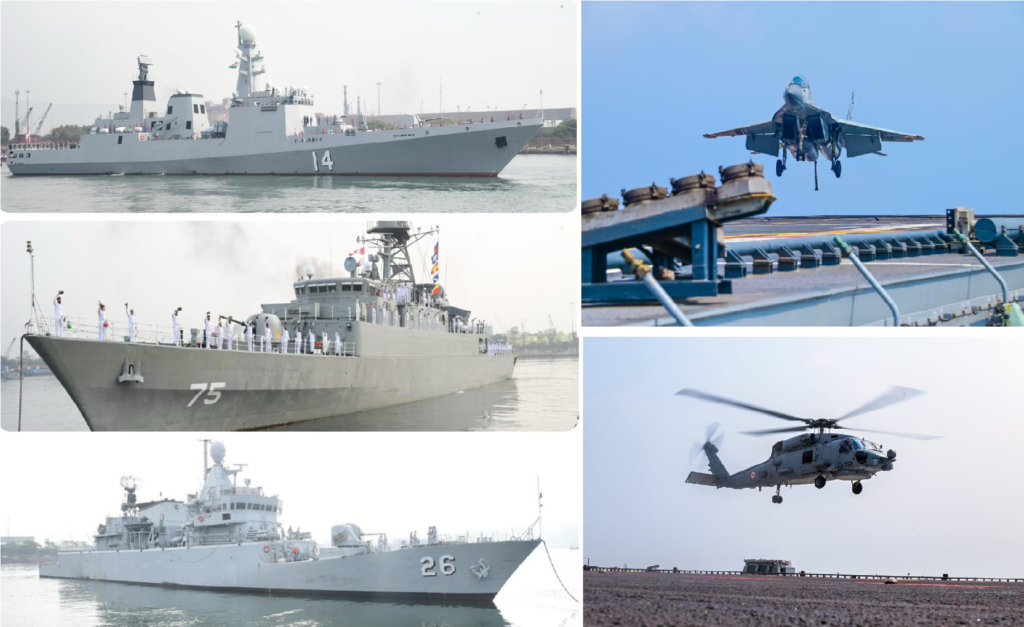
- The nine-day mega naval exercise will involve the participation of over 50 countries with around 14 new nations participating in this for the first time.
- India’s Milan Exercise not only does promote multilateral partnerships with like-minded nations but also, promotes the indigenous push under their ‘Aatmanirbhar Bharat’ policy.
- ‘Milan’ 2024 would be an important benchmark towards getting more active partners from various conflict zones.
- Indian Navy has stated the importance of this year’s Milan Exercise by highlighting the need to strengthen regional cooperation and maritime security, foster interoperability and have a good understanding between various nations while providing a platform for sharing best practices with expertise.
India recently kicked off the multilateral Naval exercise ‘Milan’, in Visakhapatnam on the 21st of February. Entering its 12th edition, Defence Minister Rajnath Singh remarked, “Our historical experience informs us that Armed Forces also play a significant role in preserving peace. It is seen in deterrence and conflict prevention.” The nine-day mega naval exercise will involve the participation of over 50 countries with around 14 new nations participating in this for the first time. The exercise comes at a time when geopolitical tensions remain high in the Red Sea as well as around the island of Taiwan.
The first phase also known as the “Harbour phase” started on the 19th of February and will end on the 23rd of February. The second phase, known as the “sea phase “ starts right after that and will involve drills akin to anti-submarine and anti-surface warfare. Following this, by the 27th, advanced air defence drills will be held as well. One notable exercise mentioned by the Times of India is that respective nations will also engage in gunnery shooting of aerial and surface targets.
The indigenous aircraft carrier, INS Vikrant will also take part and the people will be able to see it on the coast of Vizag alongside the INS Vikramaditya. The Indian navy will showcase an armada of nearly 20 ships, and 50 aircraft which include the Mig 29K, Light Combat Aircraft Tejas and P-8l long-range maritime reconnaissance and anti-submarine warfare aircraft.
Nations such as the United States of America, Japan, South Korea, Australia, France, Bangladesh, Vietnam, Indonesia Malaysia, Russia, Seychelles, Maldives and Sri Lanka are some of the predominant nations participating in this exercise. The Russian navy’s Slava class Cruiser, Varyag (011) also joined on Monday and was welcomed by the Indian navy.
Countries that are participating for the first time in the Milan Exercise are – Canada, Eritrea, Fiji, Gabon, Germany, Iraq, Italy, Kuwait, Madagascar, Nambia, Papua New Guinea, Peru, Spain, Timor Leste and Yemen.
Vivek Madhwal, the spokesperson of the Indian navy stated the importance of this year’s Milan Exercise by highlighting the need to strengthen regional cooperation and maritime security, foster interoperability and have a good understanding between various nations while providing a platform for sharing best practices with expertise.
The Significance of the Exercise
Milan started way back in 1995 and the importance of the ‘Look East’ policy played a role in it. Countries like Singapore, Thailand, Sri Lanka, and Indonesia were the first participants in this event. To see the number growing from then till this point is a welcome change and enhances the importance of the Indian Navy as well as the Indian role in the Indo-Pacific. India is not just limiting itself to its Asian partners but also bringing those from West Asia, North America, Africa and Latin America.
It’s important to note that until the 10th edition, the exercise was always held under the aegis of the Andaman and Nicobar Command. Since then, it’s the second time Visakhapatnam has hosted the exercises and that too with a large number of navies involved with more armada at display. This hints at the increase in development in terms of a good chain of command and the importance of India’s rising stature in maritime affairs. India’s push for navigation freedom has appealed towards many nations and therefore, one must also commend the fact that Naval exchanges have only increased since 1995.
One important point is the absentees in this list of nations, especially China. As geopolitical tensions spread and positions are undertaken, these patterns reflect on the participation of nations in such important defence exercises. In this, it’s important to note that both Russia and the US are participating in a common event, highlighting the obvious belief they have in India as a reliable partner to both nations and in its way to manage even the most bitter rivals together. This signals another touch on India’s mature foreign policy at work which even today, gets a warm reception from the global South and a mild irritated reception from the West.
It’s my understanding that all facets and approaches taken by India in this day and age reflect in the way they are hosting these exercises. Naval, Airforce or Army drills are not isolated from foreign policy objectives and International politics. India’s Milan Exercise not only does promote multilateral partnerships with like-minded nations but also, promotes the indigenous push under their ‘Aatmanirbhar Bharat’ policy. Hence Milan 2024 would be an important benchmark towards getting more active partners from various conflict zones. If not trust, it’s the predictable behaviour that India has kept for other nations to relate to and join them in this important Naval exercise.
(Anhad Jakhmola is a postgraduate scholar in international relations. He has his undergraduate degree in history and is pursuing his Ph.D. in Defence and Strategic Studies. He is a columnist for many portals and is a keen public speaker in debates and discussions. Views expressed are author’s own)

